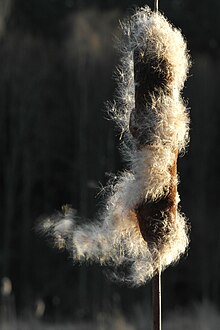
Back Јеекен ALT بوط Arabic بوط ARZ Екән Bashkir Šėndros BAT-SMG Рагоз Byelorussian Папур Bulgarian Boga Catalan Typha CEB Orobinec Czech
| Typha | |
|---|---|

| |
| Typha latifolia | |
| Scientific classification | |
| Kingdom: | Plantae |
| Clade: | Tracheophytes |
| Clade: | Angiosperms |
| Clade: | Monocots |
| Clade: | Commelinids |
| Order: | Poales |
| Family: | Typhaceae |
| Genus: | Typha L. |
| Synonyms[1] | |
| |
| Nutritional value per 100 g (3.5 oz) | |
|---|---|
| Energy | 106 kJ (25 kcal) |
5.14 g | |
| Sugars | 0.22 g |
| Dietary fiber | 4.5 g |
0.00 g | |
1.18 g | |
| Vitamins | Quantity %DV† |
| Vitamin A equiv. | 0% 1 μg0% 6 μg |
| Thiamine (B1) | 2% 0.023 mg |
| Riboflavin (B2) | 2% 0.025 mg |
| Niacin (B3) | 3% 0.440 mg |
| Pantothenic acid (B5) | 5% 0.234 mg |
| Vitamin B6 | 7% 0.123 mg |
| Folate (B9) | 1% 3 μg |
| Choline | 4% 23.7 mg |
| Vitamin C | 1% 0.7 mg |
| Vitamin K | 19% 22.8 μg |
| Minerals | Quantity %DV† |
| Calcium | 4% 54 mg |
| Copper | 5% 0.041 mg |
| Iron | 5% 0.91 mg |
| Magnesium | 15% 63 mg |
| Manganese | 33% 0.760 mg |
| Phosphorus | 4% 45 mg |
| Potassium | 10% 309 mg |
| Selenium | 1% 0.6 μg |
| Sodium | 5% 109 mg |
| Zinc | 2% 0.24 mg |
| Other constituents | Quantity |
| Water | 92.65 g |
| †Percentages estimated using US recommendations for adults,[2] except for potassium, which is estimated based on expert recommendation from the National Academies.[3] | |
Typha /ˈtaɪfə/ is a genus of about 30 species of monocotyledonous flowering plants in the family Typhaceae. These plants have a variety of common names, in British English as bulrush or reedmace,[4] in American English as reed, cattail,[5] or punks, in Australia as cumbungi or bulrush, in Canada as bulrush or cattail, and in New Zealand as reed, cattail, bulrush or raupo. Other taxa of plants may be known as bulrush, including some sedges in Scirpus and related genera.
The genus is largely distributed in the Northern Hemisphere, where it is found in a variety of wetland habitats.
The rhizomes are edible, though at least some species are known to accumulate toxins and so must first undergo treatment before being eaten.[6] Evidence of preserved starch grains on grinding stones suggests they were already eaten in Europe 30,000 years ago.[7]
- ^ "World Checklist of Selected Plant Families: Royal Botanic Gardens, Kew". kew.org.
- ^ United States Food and Drug Administration (2024). "Daily Value on the Nutrition and Supplement Facts Labels". Retrieved 2024-03-28.
- ^ National Academies of Sciences, Engineering, and Medicine; Health and Medicine Division; Food and Nutrition Board; Committee to Review the Dietary Reference Intakes for Sodium and Potassium (2019). Oria, Maria; Harrison, Meghan; Stallings, Virginia A. (eds.). Dietary Reference Intakes for Sodium and Potassium. The National Academies Collection: Reports funded by National Institutes of Health. Washington, DC: National Academies Press (US). ISBN 978-0-309-48834-1. PMID 30844154.
- ^ Clegg, J. (1986). Observer's Book of Pond Life. Frederick Warne, London. 460 p.
- ^ USDA, NRCS (n.d.). "Typha". The PLANTS Database (plants.usda.gov). Greensboro, North Carolina: National Plant Data Team. Retrieved 12 December 2015.
- ^ State of Victoria (Agriculture Victoria). "Cumbungi". Victorian Resources Online. Agriculture Victoria. Archived from the original on 24 March 2022. Retrieved 4 February 2023.
- ^ Revedin, A.; et al. (2010). "Thirty thousand-year-old evidence of plant food processing". Proc Natl Acad Sci U S A. 107 (44): 18815–18819. Bibcode:2010PNAS..10718815R. doi:10.1073/pnas.1006993107. PMC 2973873. PMID 20956317.
© MMXXIII Rich X Search. We shall prevail. All rights reserved. Rich X Search